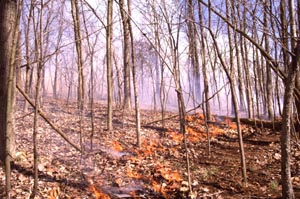
"The moon shines faintly through a veil of mist and smoke, accumulated from the slow fires that have all day crept lazily through the saturated grass."
- from Eliza W. Farnham’s Life in Prairie Land
Fires need to burn slow and under control for restoration projects. Since preserved prairies are usually close to roads, houses, farms, or other preserved land, the fires must not go beyond the site. Natural and man-made firebreaks are used to help slow down or stop fires. Rivers, creeks, ponds, ditches, and roads are all fire breaks.
Firebreaks are created when preparing the site for a burn. Mowing or raking to remove all the organic material around the boundary of a prairie site helps create a safe border.
A backfire, a fire that burns into the wind, increases the firebreak and is used especially near a road or other potentially hazardous boundary area. These fires burn slowly and can be controlled more easily.
Once proper fire breaks are in place, a head fire, a fire that burns with the wind, can be started. These move much faster than a backfire and must be monitored.
Everyone who participants in prescribed burns must be educated about proper safety precautions.
|
|
Copyright © 2000 Illinois State Museum
